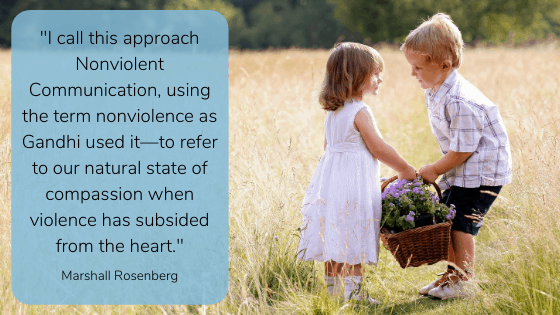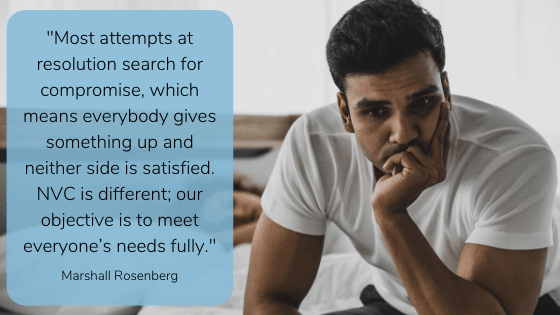How Nonviolent Communication Completely Transformed My Relationships
Out of the countless self-improvement books I’ve read over the past few years, none of them can compare to the impact that Nonviolent Communication by Marshall Rosenberg had on my life. It improved my parenting more than any parenting book. It improved my marriage better than any marriage book. And it improved my relationship with myself better than any book about self-compassion. In short, learning Nonviolent Communication was life-changing for me.
THE MINDSET OF NONVIOLENT COMMUNICATION
Nonviolent Communication is exactly what it sounds like: communication free of violence. When we have an emotional reaction to something that someone else did or said, we often react violently using verbal abuse (i.e. “You idiot! What were you thinking!?”). Nonviolent Communication provides us an alternative, a language we can use to resolve conflicts peacefully.

Behind the language of Nonviolent Communication is a mindset of unconditional love (See “How to Develop Unconditional Love: A Scientific Approach”). Such a mindset requires that we view every person we meet as a perfectly normal human being. No matter what emotional reaction we have to their behavior, we continue to view them as perfectly normal. We do this by considering the universal human needs that they are trying to meet through their behavior.
For instance, if someone steals food from us, we will likely feel very frustrated about what they did. Nonviolent Communication suggests that in order to maintain unconditional love towards them, we need to ask ourselves, “what universal human need were they trying to meet by stealing my food?” The answer is simple, and it reminds us that deep down, the other person is just human. Not “good” or “evil,” just a normal human trying to get their needs met.
THE LANGUAGE OF NONVIOLENT COMMUNICATION
From this place of unconditional love for the individual, we can address their behavior. We do this by expressing the four components of Nonviolent Communication:
- Observations
- Feelings
- Needs
- Requests
These four components can be expressed one at a time or altogether. For instance, we might say, “When you took my food without asking (observation), I felt scared (feeling) because I want to feel safe (need). Next time, instead of taking my food, would you please just ask me for some (request)?” Sticking with observations, feelings, needs, and requests allows us to fully express our frustration in a completely nonviolent way.
NONVIOLENT COMMUNICATION VS. VIOLENT COMMUNICATION
Before studying Nonviolent Communication, I studied violent communication (See “100+ Tactics to Control, Manipulate, and Verbally Abuse”). I found that I was better able to use Nonviolent Communication when I was able to recognize its opposite. This way, if I ever found myself about to speak violently, I was able to catch myself and try again using Nonviolent Communication. For this reason, I want to briefly outline how the four components of Nonviolent Communication compare to violent forms of communication.
Observations
Observations are behaviors that you can see or hear. They are observed, non-disputable, specific facts (i.e. “you took my food without asking”). They are not:
- Judgements: “You have no respect for other people, you thief!”
- Spiritual Legalism: “Stealing is a sin! Don’t you know that thieves go to hell?”
- Generalizing: “You tend to take things from people sometimes.”
- Exaggerating: “You are always taking my stuff!”
- Comparing: “None of your siblings steal, so why do you think you have to?”
- Diagnosing: “You’re crazy! You must have kleptomania or something…”
- Sarcasm: “It must be exhausting running around taking everyone’s stuff. And I thought I was a hard worker. Sheesh!”
- Labelling: “You’re a thief!”
- Correcting: “Didn’t anyone ever teach you that it’s not appropriate to take things that don’t belong to you?!”
- Passive Aggressive tactics such as Gossip, Triangulation, Abusive Jokes/Gifts, Public Humiliation, or the Silent Treatment.

Feelings
Feelings are the emotions you experience (i.e. “I felt scared”). They are not:
- Abusive Anger: “I’m so mad I could punch you in the face! How dare you take my food you ungrateful swine!”
- Defining: “I feel like you don’t care about anyone but yourself.”
- Spiritual Legalism: “I feel like God is unhappy with you right now”
- Catastrophizing: “I feel like you would rather me be dead so you could just take all my stuff. I must mean nothing to you!”
- Entitlement: “I feel like I deserve better than what you’ve done to me.”
- Should-ing: “I feel like you should know better.”
- Threats: “I feel like I’m going to have to cut you out of my life if you keep this up.”
Needs
Needs are our own unmet internal desires and needs (See "30+ Human Needs: A Comprehensive List"). They are the cause for the feelings we felt (i.e. “I want to feel safe”). They are not:
- Blame: “I felt scared because you disrespected my property.”
- Defining: “I felt scared because you tried to hurt me.”
- Entitlement: “I felt scared because I deserve to feel safe.”
- Diagnosing: “I felt scared because you are out of your mind.”
Requests
Requests are specific actions we’d like the other person to take so that our needs will be met (i.e. “next time, instead of taking my food, would you please just ask me for some?”). They are not:
- Demands: “Never, ever do that to me again!”
- Unsolicited Advice: “I’d suggest getting food stamps.”
- Should-ing: “You should never take someone else’s food.”
- Threats: “If you ever take my food again, I’m going to beat you to a pulp!”
- Bribery: “If you can stop stealing my food for the rest of the month, I’ll give you a loaf of bread.”
- Title Intimidation: “I’m a cop, so you better not mess with me again!”
- Abuse of Power: “I’m your father, and if this kind of behavior continues, you’ll be grounded until your 18!”

THE TRANSFORMATIVE POWER OF NONVIOLENT COMMUNICATION
As I began to implement Nonviolent Communication, I noticed a dramatic transformation in my relationship with myself, my spouse, my children, and everyone around me.
Myself
Nonviolent Communication improved my relationship with myself by helping me improve my self-talk (how you talk to yourself) and work through past trauma.
Successful Self-Talk
Over the years, I’ve heard a lot about the importance of self-talk, but I never felt like I had gotten a solid grasp on it. Nonviolent Communication was able to finally provide me with a model for effective, loving self-talk.
My self-talk becomes very noticeable when I’m playing basketball: “Ugh, I should’ve made that basket!”, “What was I thinking?!”, “What’s wrong with me today?”, or “I always miss three-pointers!” are just a few examples of things I might catch myself saying.

Now, I’m getting better at transforming my violent self-talk into Nonviolent Communication using the 4 components:
- Observation: “That shot didn’t go far enough.”
- Feeling: “I’m feeling nervous.”
- Need: “I want to feel like a competent player.”
- Request: “Next time, I’ll bend my knees more.”
When I infuse my self-talk with Nonviolent Communication, I play better and I feel better. It’s a win-win.
I’ve also been working on the self-talk I use when I make a mistake in my personal life (like yelling at my kids). Instead of judging myself (“I’m such an awful dad.”), I try to think about the need I was trying to meet when I made the mistake (“I yelled because I needed control over the situation”). I also try to focus on how I am feeling about the mistake and what need was compromised when I made the mistake (“I feel sad about this mistake because I want to be a competent, loving father”). I then look for ways to honor my feelings and meet both of these needs (“Next time, if I’m feeling overwhelmed, I could put on a 3-minute YouTube video for the kids while I take a break to clear my mind”). This self-talk is both loving and productive.
When I infuse my self-talk with Nonviolent Communication, I play better and I feel better. It’s a win-win.
Healing From Trauma
Nonviolent Communication has also been the key to finding healing from past trauma. As I try to uncover the 4 components within my past experiences, I find that I’m better able to move on and leave the past behind me:
- Observations: “What happened exactly? What clear memories do I have of the event?”
- Feeling: “How do I feel about what happened?”
- Need: “Why do I feel that way? What need was negatively impacted by that event?”
- Request: “What can I do moving forward to meet that need?”
Sometimes simply reflecting on the event in this manner is enough to enable me to move on. Other times, though, I need a little extra support by talking things through with someone. After learning about Nonviolent Communication, I specifically sought out a therapist trained in Nonviolent Communication, and she’s the best therapist I’ve ever worked with. Using Nonviolent Communication, she’s helped me heal from traumatic events that haunted me for years.
Accepting Myself Fully
Before learning about Nonviolent Communication, I had a tendency to dismiss my negative thoughts (i.e. "I hate being a dad"). Or worse, I'd believe that any negative thought was an indication that perhaps I was a bad person. Now, I'm able to see these negative thoughts as a simple indicator that I have unresolved feelings and an underlying need that isn't being met (i.e. I'm tired and need some rest). Exploring the negative thought using Nonviolent Communication, allows me to understand what I need while seeing myself as a perfectly normal human being.
Additionally, I'm working on overcoming my tendency to dismiss positive thoughts (i.e. "I'm a good basketball player"). In the past, I might have pushed this thought away for fear of becoming prideful. Now, I can see that it is simply an indicator that one of my underlying needs has been met (i.e. I feel happy because my need for competency is being met). Seeing my positive thoughts in this light allows me to deeply soak in the joy that comes from getting my needs met (See "How to be Happy Right NOW").
I'm beginning to see that my thoughts and behavior are merely the tip of the iceberg. To truly understand myself, I need to dig deeper using Nonviolent Communication. When I'm able to understand the feelings and needs that resulted in my behavior, I'm able to accept myself fully while discovering new ways to move forward.

My Marriage
Nonviolent Communication helped me become more empathic and resolve seemingly unsolvable marital challenges.
Becoming a More Empathic Husband
Previously, when my wife Lindsey would express her emotions, I would get caught up in the problem she was experiencing or the thoughts in her head. In contrast, Nonviolent Communication recommends focusing on the observations, feelings, needs, and requests of the other person. This really helps me listen to Lindsey on the deepest possible level.
For instance, today she was telling me that she has to tell our 4-year-old son something at least five times before he listens and does it. Before learning Nonviolent Communication, I might have tried to fix the problem by offering Lindsey a solution. Or, I might have judged Lindsey for complaining or for not finding a solution herself. My head would have been focused on fixing the problem or fixing Lindsey.
With Nonviolent Communication, I can listen to her knowing that she doesn’t need fixing and neither does the problem. What I need to do is simply reflect back her observations, feelings, needs, and requests:
- Observation: “Can you give me an example of when he did this?”
- Feeling: “Yah, that’s frustrating...”
- Need: “Especially when you are in a rush and need to get somewhere…”
- Request: At first, I could tell she simply needed someone to express her frustration to. After she felt heard, she asked me for my advice in handling the situation.
In essence, Nonviolent Communication has helped me focus on what is really going on inside of her (her observations, feelings, needs, and requests) rather than on the problem, her thoughts, or my judgements of the situation. It has helped me connect with her on a much deeper level.
Working Through Challenges
Before learning Nonviolent Communication, sometimes I’d be afraid to express my frustration about something to Lindsey for fear that it might upset her. I think this fear came from not knowing the difference between nonviolent and violent communication. Now that I understand the distinction, I feel very comfortable expressing observations, feelings, needs, and requests, knowing that I’m expressing myself in a nonviolent way.
This increased comfort in opening up has allowed us to work through issues together much more effectively. We are able to bring them into the light more clearly by expressing observations and feelings. Then we are able to examine the unmet needs and come up with creative solutions for meeting those needs. Nonviolent Communication has helped us communicate more often and more effectively, allowing us to work through seemingly unsolvable challenges.
Bonus Tip: Do a Relationship Inventory Every Week
In our busy day-to-day lives, it can be hard to find time to discuss issues. Additionally, discussing issues during the day may make the conversation more stressful because one or both of you may already be stressed about something else going on at the moment. For this reason, I'd highly recommend setting aside a time every week to check in on the relationship. During ours, we discuss what we are good at as a couple, discuss any conflicts using Nonviolent Communication, and we share two positive things we noticed about the other person during the previous week. We've simply included our relationship inventory as part of our weekly meeting (See "How We Do Weekly Family Meetings").

My Children
The parent-child relationship is just one big communication challenge. As the parent, you want control over these seemingly wild animals who live in your house. And the children want to control you so that they can have as much freedom and independence as possible. This results in both parents and children resorting to control tactics, often in the form of verbal abuse.
By replacing verbally abusive communication with nonviolent communication, I’ve noticed a dramatic improvement in my ability to handle parenting challenges. I’m better able to understand my kids’ behavior, and I’m better able to meet my own needs as a parent.
Seeing the Rationale Behind Seemingly Irrational Behavior
One of the biggest challenges of parenting is simply understanding the seemingly irrational behavior of your children. The adult mind simply cannot compute sometimes. Nonviolent Communication has helped me dramatically with this. Now, whenever my kids do something that causes me to have an emotional reaction (i.e. all the time!), I try to think about the feelings and needs behind their behavior.
For example, if my 4-year-old son is crying a lot and yelling at me during breakfast, I might consider that he is still tired from waking up and that he needs me to comfort him. By addressing his underlying feelings and needs, I’m able to resolve the problem much better than if I try to address it using violent communication:
- Threats/Punishments: “Stop crying or I’m not going to let you watch any TV today.”
- Bribes: “If you stop crying, I’ll give you an extra piece of candy for dessert.”
- Judgements: “It’s not nice to cry and yell.”
- Demands: “Stop yelling!”
- Diagnosing: “Ugh, you are such a baby! Why won’t you just act your age?!”

These common parenting approaches may get an immediate result, but they fail to address the underlying cause of the behavior (the unresolved feelings and unmet needs).
Understanding and Attending to My Own Feelings and Needs
Parenting is hard. Very hard. It is totally and completely draining. The fight against parenting burnout is a constant struggle.
In winning this fight, I’ve found that the more I can maintain a connection to my own feelings and needs, the better I am at staying at the top of my game. When I stop paying attention to my feelings and needs, I start to burn out, and once I’m burnt out, I’m not a very fun parent to be around.
When I stop paying attention to my feelings and needs, I start to burn out, and once I’m burnt out, I’m not a very fun parent to be around.
Practicing Nonviolent Communication has helped me better take care of my own feelings and needs, particularly when my kids are stomping on them. Going back to the example of my son yelling at me, just because I understand the feelings and needs behind his actions doesn’t mean I’m not affected by his behavior. I am. It is no fun being yelled at.
Instead of letting him walk all over me, I express my frustration fully through Nonviolent Communication: “When you yell at me (observation), my ears hurt and I feel frustrated (feelings). Will you please stop yelling at me (request)?”
Not only does this allow me to fully express myself, but it also helps my son understand how his actions affect others. I’ve also noticed that me using Nonviolent Communcation increases his capacity to understand his own emotions and express them: “Daddy, I’m feeling frusterated...” He is starting to use Nonviolent Communication more and more each day (See "How to Build a Strong Family Culture: A Step-by-Step Guide").
Everyone Around Me
Nonviolent Communication not only impacted my closest relationships but also my relationships with everyone around me. It helps me have empathy for others, and it also helps me express myself to them more clearly. Here are a few things I’ve learned about using Nonviolent Communication in everyday life:
Nonviolent Communication is Meant for Emotional Situations
When I first learned Nonviolent Communication, I thought it was something you had to use all the time. After all, I figured if I wasn’t communicating nonviolently, I must be communicating violently. But, I quickly realized that Nonviolent Communication is something that should be used within a specific context: emotional situations. Trying to use it outside of that context is ineffective and awkward.
I Don’t Need to Tolerate Hurtful Behavior
Just because I can use Nonviolent Communication to understand the feelings and needs behind another person’s hurtful behavior doesn’t mean I have to tolerate it. If I’ve made a request for someone to stop treating me in a hurtful way and they’ve refused to honor my boundaries, I don’t have to tolerate it. I can choose to remove myself from the situation. To me, this is an essential part of honoring my own feelings and needs (See "The #1 Roadblock to Being Your Authentic Self").
If I’ve made a request for someone to stop treating me in a hurtful way and they’ve refused to honor my boundaries, I don’t have to tolerate it.
I Don’t Need to Fully Express Myself to Everyone
There are times when I don’t feel safe expressing my observations, feelings, needs, and/or requests to someone. I believe it is important for me to pay attention to this feeling of discomfort and honor it by not sharing what is inside of me. Some things are better for me to work through on my own.
Learning to Naturally Use Nonviolent Communication Takes Time
When you first learn Nonviolent Communication, it feels weird to implement because you only know the textbook format: “When you... (observation), I feel… (feeling), because I… (need). Would you be willing to… (request)” Using this prescribed format for expressing oneself is unnatural and awkward. Don’t worry. Over time, you will get better at expressing your observations, feelings, needs, and requests more naturally without sounding like a Nonviolent Communication robot.
One thing that has helped me is to know that I don’t have to express all four components every time I encounter an emotional situation. Oftentimes, components can be expressed nonverbally or are implied, so they can be left out.
Sometimes, it depends on who I am talking to. When I’m talking with my kids, I try to express all four components as much as possible so that they can fully understand me and so that they learn from it. When I’m talking with Lindsey, on the other hand, usually one or two components will suffice. As you put it into practice, you will start to find out what works for you.
Getting Started with Nonviolent Communication
To get started with Nonviolent Communication, I’d recommend listening to the audiobook with your spouse, partner, or family. It’s only a few hours long (I’d suggest listening at 1.5x speed since Marshall Rosenberg talks kinda slow...). I’d recommend pausing it every now and then to talk about the concepts together. My wife and I did this and it was super helpful to work on applying it as a couple.
After listening to the audiobook, I’d recommend reading the book to gain a deeper understanding. I enjoyed being able to slow down and process each concept on my own.
From there, the challenge is implementing it into your daily life. To help myself practice, I created a Google Sheet/Form that walked me through approaching emotional situations using Nonviolent Communication. You can make your own copy by clicking here.

Implementing Nonviolent Communication takes time and will certainly feel awkward at first. That’s okay. If you are trying to maintain a mindset of unconditional love while focusing on feelings and needs, you are on the right track. You’ll likely mess up over and over again, but you’ll get better over time. Just remember what Marshall Rosenberg says, "Anything that's worth doing is worth doing poorly."1 And learning to use Nonviolent Communication is definitely worth doing.
Hi fellow human! Thanks for visiting my personal blog. I’m an intentional family man who is currently passionate about parenting, family culture, homeschooling, and self improvement. This blog isn’t a business. It’s just my way of connecting with people with just as much passion for these topics as me. So, if you enjoy my musings, be sure to reach out.
- Nonviolent Communication by Marshall B. Rosenberg

